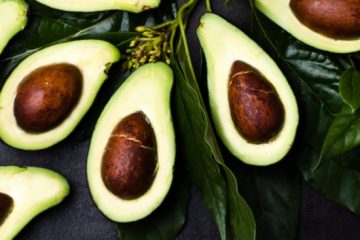It’s probably safe to say that most of us love eating fried foods from time to time. Unfortunately, mainstream diet advice has made many of us feel like it’s a guilty pleasure or, worse yet, “a heart attack waiting to happen.” Fortunately, the Keto Diet turns all of that nonsense on its head! With a ketogenic lifestyle, fats and frying oils are back on the menu again! But even on a ketogenic diet plan, it’s not smart to eat foods fried in just any kind of frying oil.
The good news is, with the right oils and higher temperatures, you can enjoy all those delicious fatty fried foods without guilt or worry.
Understanding fats in general can be confusing, and adding high heat frying into the mix adds another layer of complexity. We all know that trans fats are unhealthy and should be avoided at all costs, but can high heat also cause fats to go bad? How do we choose the best oils to cook and fry with? And what role do they play in our long-term wellness and longevity?
The first thing to consider when cooking and frying with fats at high temperatures, is their smoke point.
Understanding Smoke Point
Pan frying food involves cooking food in a skillet (like a cast iron or frying pan) to temperatures of around 250℉. Deep frying involves heating the frying oil to temperatures of around 320-360℉, and fully submerging the food in the oil. Much like its name suggests, smoke point refers to the temperature at which an oil heats up and starts to burn and smoke. When oils are cooked past their smoke point the flavor of the oil changes (to a burnt taste), and many of the beneficial nutrients are destroyed. Heating up oil to its smoke point will also increase the oxidation rate and release free radicals that can damage your cells. You will know when you’ve reached an oil’s smoke point because it will begin to smell and produce a blueish smoke. You don’t want that!
Oils with higher smoke points are the best for deep frying or high-heat cooking. Smoke point relates to an oil’s saturation. For example, polyunsaturated oils (typically from nuts, seeds, and fish) are the most unstable oils, so they are more susceptible to rancidity and oxidation. They should not be used as frying oils or even really heated. Reserve them for making your own dressings or drizzling on steamed leafy greens.
Some monounsaturated fats and all saturated fats, however, have higher smoke points. They can safely be used in high-heat cooking and deep frying. Let’s take a look at the 5 best frying oils for the Keto Diet.
Best Keto Frying Oils
Coconut Oil | Smoke point: 400℉
Some believe that coconut oil is one of the healthiest foods on the planet. Coconut oil is extremely stable as a cooking oil, rich in medium chain fatty acids, easy for your body to digest, antimicrobial and antifungal, and particularly rich in lauric acid which is known to be an immune booster. If you are put off by the strong coconut flavor, it is worth noting that it typically loses some of its flavor when heated.
Storage: Coconut oil should be stored in an airtight container at room temperature and last for up to two years.
Some of our favorite foods to fry in coconut oil are:
- eggs
- keto pancakes
- meats
- chicken wings
- coconut encrusted shrimp
- stir-fried vegetables
- keto legal donuts
- other keto baked goods
Coconut oil is also good added to keto coffee (or try our Guy Gone Keto MCT oil).
Ghee | Smoke Point 485℉
Ghee (clarified butter) originated in India where the hot climate required a fat that was more shelf-stable than butter. To make ghee, whole-fat butter is simmered until the milk solids rise to the top. They are then skimmed off. This leaves a golden buttery oil that no longer contains lactose (which is great for lactose-intolerant folks). Ghee is a saturated fat high in vitamins A, E, and K2, as well as trace minerals. With its high smoke point and delicious buttery flavor, ghee is quickly becoming a favorite high-heat cooking fat.
Storage: Ghee can be stored in an airtight container at room temperature for up to a year or in the refrigerator to maintain freshness for a longer period of time.
Because of its versatility and flavor, ghee can be used to cook:
- pancakes
- stir-fry vegetables
- meats
- fried or scrambled eggs
- oven-roasted meats and vegetables
Ghee is also delicious added to keto coffee along with coconut oil or MCT oil.
Tallow (beef fat) | Smoke Point: 420℉
Tallow is rendered fat from animals other than pork and most commonly comes from beef. It is a great fat for high-heat cooking or frying. Grass-fed tallow in particular is high in vitamin D, A, E, and K and also high in antioxidants. Tallow has long been a chef favorite because of its amazing flavor, high smoke point, and ability to resist rancidity. In fact, tallow used to be the main frying fat used by fast food restaurants for deep frying until the 1970s when it was replaced by much cheaper vegetable oils.
Storage: Tallow can be stored in an air-tight container at room temperature for up to a year or in the refrigerator for a longer shelf life.
When cooking, tallow is a great oil for deep frying:
- french fries and chips (made with low carb root veggies like jicama, rutabaga or parsley root)
- chicken/turkey
- fish
- stir fried vegetables
- any egg dish
Lard (pig fat) | Smoke Point: 400℉
Until the early 1900s, lard was a staple cooking fat used in many kitchens around the world. Similar to tallow, it was most commonly used prior to the industrial vegetable oil boom. Because of its neutral flavor, it was the default fat used for baking, frying, and even smearing on your toast. Lard is lower in saturated fats than other animal fats and higher in monounsaturated fat with the added benefit of extra vitamin D.
Storage: Lard should be stored in an air-tight container in the refrigerator for up to a year or in the freezer for a longer shelf life.
Because if its high smoke point and neutral flavor, lard is the perfect oil for deep frying. It works amazingly well for:
- braised meats
- chicken/turkey
- cauliflower “pop corn”
- cheese balls
- jalapeno poppers
- bacon (yes, we fry our bacon in more bacon fat!)
Lard is also good as a binder in:
- keto tortillas and wraps
- keto pie crusts
- keto donuts and biscuits
Avocado Oil | Smoke Point: 520℉
As the popularity of avocado has skyrocketed in recent years, so too has the popularity of all of its byproducts. Avocado oil in particular is a new favorite high-heat cooking fat. Pressed from the pulp of the fruit rather than the seed, this oil is a nutrition powerhouse. Composed of primarily monounsaturated fats, it is one of the healthiest cooking oils available with high levels of oleic acid, carotenoids, lutein, and vitamin E. It is stable, mild flavored, delicious, and easy to use. All this makes it ideal for high-heat frying, pan roasting, and grilling.
Storage: Avocado oil should be stored at room temperature in an airtight container and will last 6-8 months.
Some of our favorite ways to use avocado oil are:
- stir fries
- roasted vegetables
- fried or scrambled eggs
- Thai omelettes
- oven roasted meats
In recent generations, many of the traditional, most stable cooking fats have all but completely disappeared from restaurants and home kitchens thanks to inaccurate myths about fat being bad. While fried foods may get a bad rap, on the Keto Diet there is no need to forgo all your oily favorites. By avoiding highly-processed fats like industrial vegetable oils and margarines, and cooking with these stable, healthier oils instead at the correct temperatures, you can enjoy your favorite indulgences.
Consuming heat-stable fats with higher smoke points are a great way to meet your macronutrient needs, and to take in some essential fats, vitamins, and minerals while you are at it!



2 Comments
Lori Clyburn · November 12, 2021 at 5:19 am
My husband wants to deep fry a turkey for thanksgiving. What is the best oil for that on keto?
Kristen Soprito · November 12, 2021 at 11:33 am
It’s always important to use an oil with a high smoke point for deep frying. We like avocado oil and many fryer manufacturer instructions will suggest peanut oil for turkey. Coconut oil and tallow are popular choices too. In many cases it will be determined by what is available in your area. Some oil options are costlier than others as well. We recommend brining a turkey before frying too. Enjoy and Happy Thanksgiving!